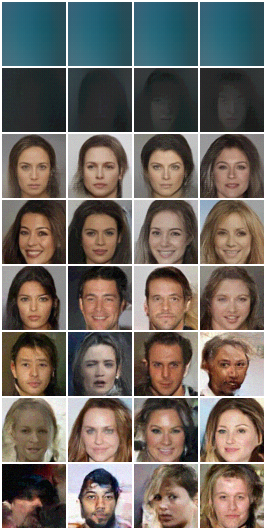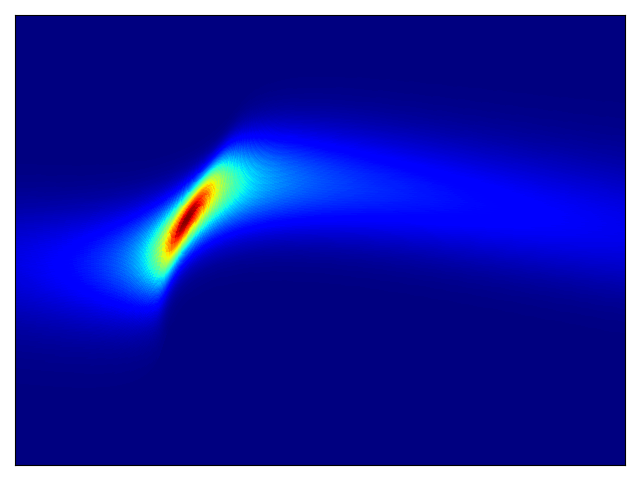Reimplementations of density estimation algorithms from:
- Block Neural Autoregressive Flow
- Glow: Generative Flow with Invertible 1×1 Convolutions
- Masked Autoregressive Flow for Density Estimation
- Density Estimation using RealNVP
- Variational Inference with Normalizing Flows
https://arxiv.org/abs/1904.04676
Implementation of BNAF on toy density estimation datasets.
Density estimation of 2d toy data and density estimation of 2d test energy potentials (cf. Figure 2 & 3 in paper):
The models were trained for 20,000 steps with the architectures and hyperparameters described in the Section 5 of the paper, with the exception of rings dataset (bottom right) which had 5 hidden layers. The models trained significantly faster than the planar flow model in Rezende & Mohamed and were much more stable; interestingly, BNAF stretches space differently and requires a lot more test points to show a smooth potential.
| Density matching on 2d energy potentials | Density estimation on 2d toy data |
|---|---|
 |
 |
 |
 |
 |
 |
 |
 |
To train model:
python bnaf.py --train
--dataset # choice from u1, u2, u3, u4, 8gaussians, checkerboard, 2spirals
--log_interval # how often to save the model and visualize results
--n_steps # number of training steps
--n_hidden # number of hidden layers
--hidden_dim # dimension of the hidden layer
--[add'l options]
Additional options are: learning rate, learning rate decay and patience, cuda device id, batch_size.
To plot model:
python bnaf.py --plot
--restore_file [path to .pt checkpoint]
- Official implementation by the authors https://github.com/nicola-decao/BNAF
https://arxiv.org/abs/1807.03039
Implementation of Glow on CelebA and MNIST datasets.
I trained two models:
- Model A with 3 levels, 32 depth, 512 width (~74M parameters). Trained on 5 bit images, batch size of 16 per GPU over 100K iterations.
- Model B with 3 levels, 24 depth, 256 width (~22M parameters). Trained on 4 bit images, batch size of 32 per GPU over 100K iterations.
In both cases, gradients were clipped at norm 50, learning rate was 1e-3 with linear warmup from 0 over 2 epochs. Both reached similar results and 4.2 bits/dim.
Temperatures ranging 0, 0.25, 0.5, 0.6, 0.7, 0.8, 0.9, 1 (rows, top to bottom):
| Model A | Model B |
|---|---|
 |
 |
| Model A | Model B |
|---|---|
 |
 |
Embedding vectors were calculated for the first 30K training images and positive / negative attributes were averaged then subtracting. The resulting dz was ranged and applied on a test set image (middle image represents the unchanged / actual data point).
| Attribute | dz range [-2, -1, 0, 1, 2] |
|---|---|
| Brown hair |  |
| Male |  |
| Mouth slightly opened |  |
| Young |  |
| Attribute | dz range |
|---|---|
| Brown hair |  |
| Mouth slightly opened |  |
To train a model using pytorch distributed package:
python -m torch.distributed.launch --nproc_per_node=NUM_GPUS_YOU_HAVE \
glow.py --train \
--distributed \
--dataset=celeba \
--data_dir=[path to data source] \
--n_levels=3 \
--depth=32 \
--width=512 \
--batch_size=16 [this is per GPU]
For larger models or image sizes add --checkpoint_grads to checkpoint gradients using pytorch's library. I trained a 3 layer / 32 depth / 512 width model with batch size of 16 without gradient checkpointing and a 4 layer / 48 depth / 512 width model with batch size of 16 which had ~190M params so required gradient checkpointing (and was painfully slow on 8 GPUs).
To evaluate model:
python glow.py --evaluate \
--restore_file=[path to .pt checkpoint] \
--dataset=celeba \
--data_dir=[path to data source] \
--[options of the saved model: n_levels, depth, width, batch_size]
To generate samples from a trained model:
python glow.py --generate \
--restore_file=[path to .pt checkpoint] \
--dataset=celeba \
--data_dir=[path to data source] \
--[options of the saved model: n_levels, depth, width, batch_size] \
--z_std=[temperature parameter; if blank, generates range]
To visualize manipulations on specific image given a trained model:
python glow.py --visualize \
--restore_file=[path to .pt checkpoint] \
--dataset=celeba \
--data_dir=[path to data source] \
--[options of the saved model: n_levels, depth, width, batch_size] \
--z_std=[temperature parameter; if blank, uses default] \
--vis_attrs=[list of indices of attribute to be manipulated, if blank, manipulates every attribute] \
--vis_alphas=[list of values by which `dz` should be multiplied, defaults [-2,2]] \
--vis_img=[path to image to manipulate (note: size needs to match dataset); if blank uses example from test dataset]
To download CelebA follow the instructions here. A nice script that simplifies downloading and extracting can be found here: https://github.com/nperraud/download-celebA-HQ/
- Official implementation in Tensorflow: https://github.com/openai/glow
https://arxiv.org/abs/1705.07057
Reimplementation of MADE, MAF, Mixture of Gaussians MADE, Mixture of Gausssians MAF, and RealNVP modules on UCI datasets and MNIST.
Average test log likelihood for un/conditional density estimation (cf. Table 1 & 2 in paper for results and parameters; models here were trained for 50 epochs):
| Model | POWER | GAS | HEPMASS | MINIBOONE | BSDS300 | MNIST (uncond) | MNIST (cond) |
|---|---|---|---|---|---|---|---|
| MADE | -3.10 +/- 0.02 | 2.53 +/- 0.02 | -21.13 +/- 0.01 | -15.36 +/- 15.06 | 146.42 +/- 0.14 | -1393.67 +/- 1.90 | -1340.98 +/- 1.71 |
| MADE MOG | 0.37 +/- 0.01 | 8.08 +/- 0.02 | -15.70 +/- 0.02 | -11.64 +/- 0.44 | 153.56 +/- 0.28 | -1023.13 +/- 1.69 | -1013.75 +/- 1.61 |
| RealNVP (5) | -0.49 +/- 0.01 | 7.01 +/- 0.06 | -19.96 +/- 0.02 | -16.88 +/- 0.21 | 148.34 +/- 0.26 | -1279.76 +/- 9.91 | -1276.33 +/- 12.21 |
| MAF (5) | 0.03 +/- 0.01 | 6.23 +/- 0.01 | -17.97 +/- 0.01 | -11.57 +/- 0.21 | 153.53 +/- 0.27 | -1272.70 +/- 1.87 | -1268.24 +/- 2.73 |
| MAF MOG (5) | 0.09 +/- 0.01 | 7.96 +/- 0.02 | -17.29 +/- 0.02 | -11.27 +/- 0.41 | 153.35 +/- 0.26 | -1080.46 +/- 1.53 | -1070.33 +/- 1.53 |
Toy density model (cf. Figure 1 in paper):
| Target density | Learned density with MADE and random numbers driving MADE |
Learned density with MAF 5 layers and random numbers driving MAF |
|---|---|---|
 |
 |
 |
Class-conditional generated images from MNIST using MAF (5) model; generated data arrange by decreasing log probability (cf. Figure 3 in paper):
To train model:
python maf.py -- train \
-- model=['made' | 'mademog' | 'maf' | 'mafmog' | 'realnvp'] \
-- dataset=['POWER' | 'GAS' | 'HEPMASS' | 'MINIBOONE' | 'BSDS300' | MNIST'] \
-- n_blocks=[for maf/mafmog and realnvp specify # of MADE-blocks / coupling layers] \
-- n_components=[if mixture of Gaussians, specify # of components] \
-- conditional [if MNIST, can train class-conditional log likelihood] \
-- [add'l options see py file]
To evaluate model:
python maf.py -- evaluate \
-- restore_file=[path to .pt checkpoint]
-- [options of the saved model: n_blocks, n_hidden, hidden_size, n_components, conditional]
To generate data from a trained model (for MNIST dataset):
python maf.py -- generate \
-- restore_file=[path to .pt checkpoint]
-- dataset='MNIST'
-- [options of the saved model: n_blocks, n_hidden, hidden_size, n_components, conditional]
Datasets and preprocessing code are forked from the MAF authors' implementation here. The unzipped datasets should be symlinked into the ./data folder or the data_dir argument should be specified to point to the actual data.
- The original Theano implementation by the authors https://github.com/gpapamak/maf/
- https://github.com/ikostrikov/pytorch-flows
Implementation of Variational Inference with Normalizing Flows
Density estimation of 2-d test energy potentials (cf. Table 1 & Figure 3 in paper).
To train model:
python planar_flow.py -- train \
-- target_potential=[choice from u_z1 | u_z2 | u_z3 | u_z4] \
-- flow_length=[# of layers in flow] \
-- [add'l options]
Additional options are: base distribution (q0) scale, weight initialization scale, weight decay, learnable first affine layer (I did not find adding an affine layer beneficial).
To evaluate model:
python planar_flow.py -- evaluate \
-- restore_file=[path to .pt checkpoint]
- python 3.6
- pytorch 1.0
- numpy
- matplotlib
- tensorboardX
- pandas
- sklearn
- h5py












